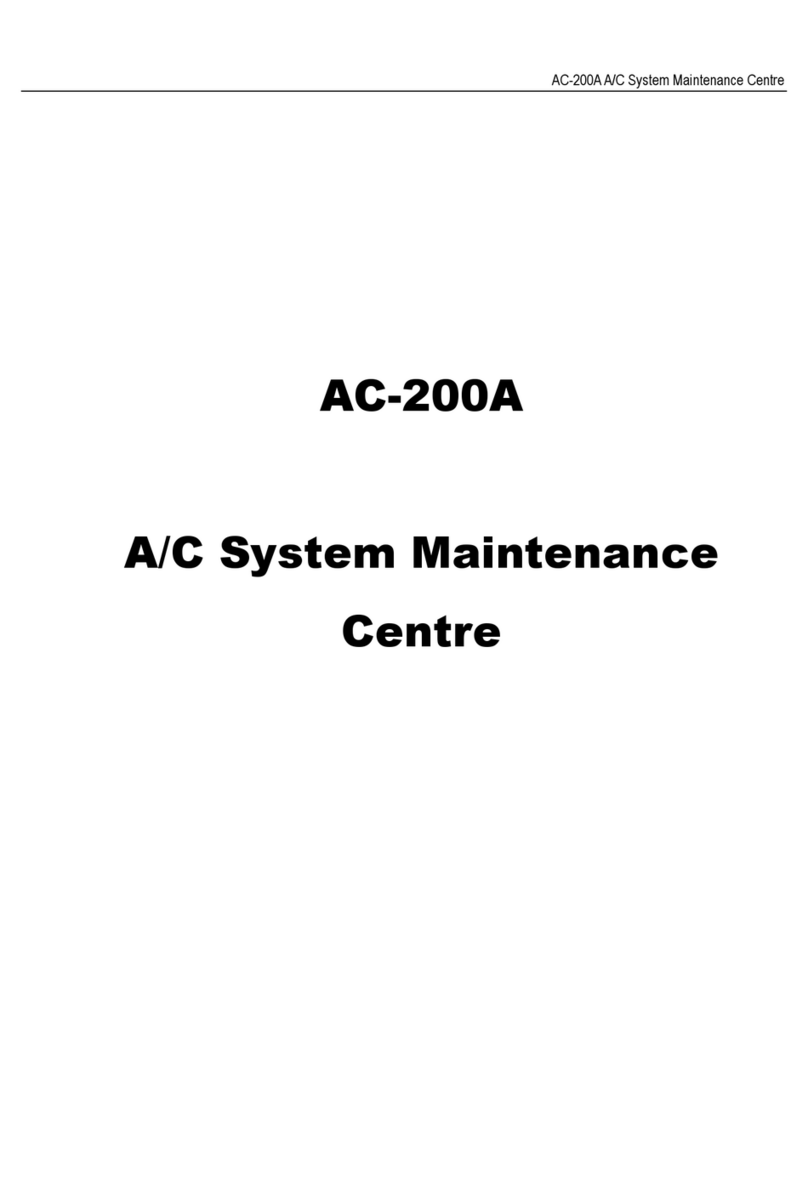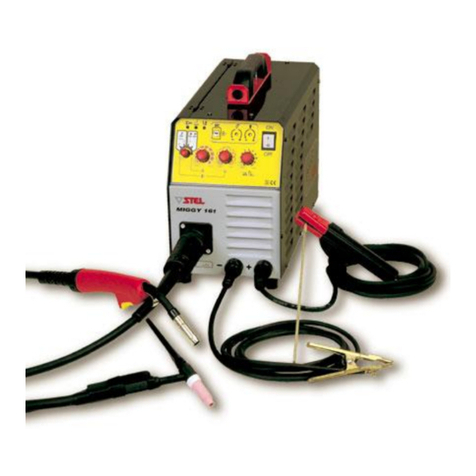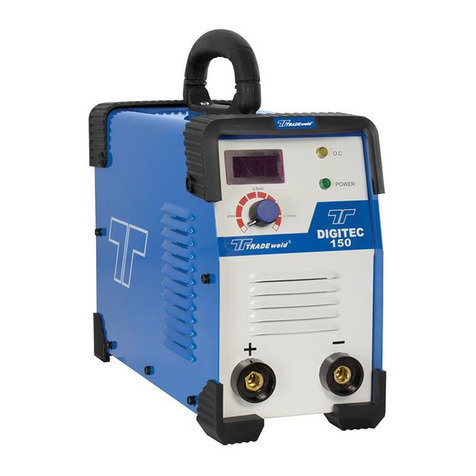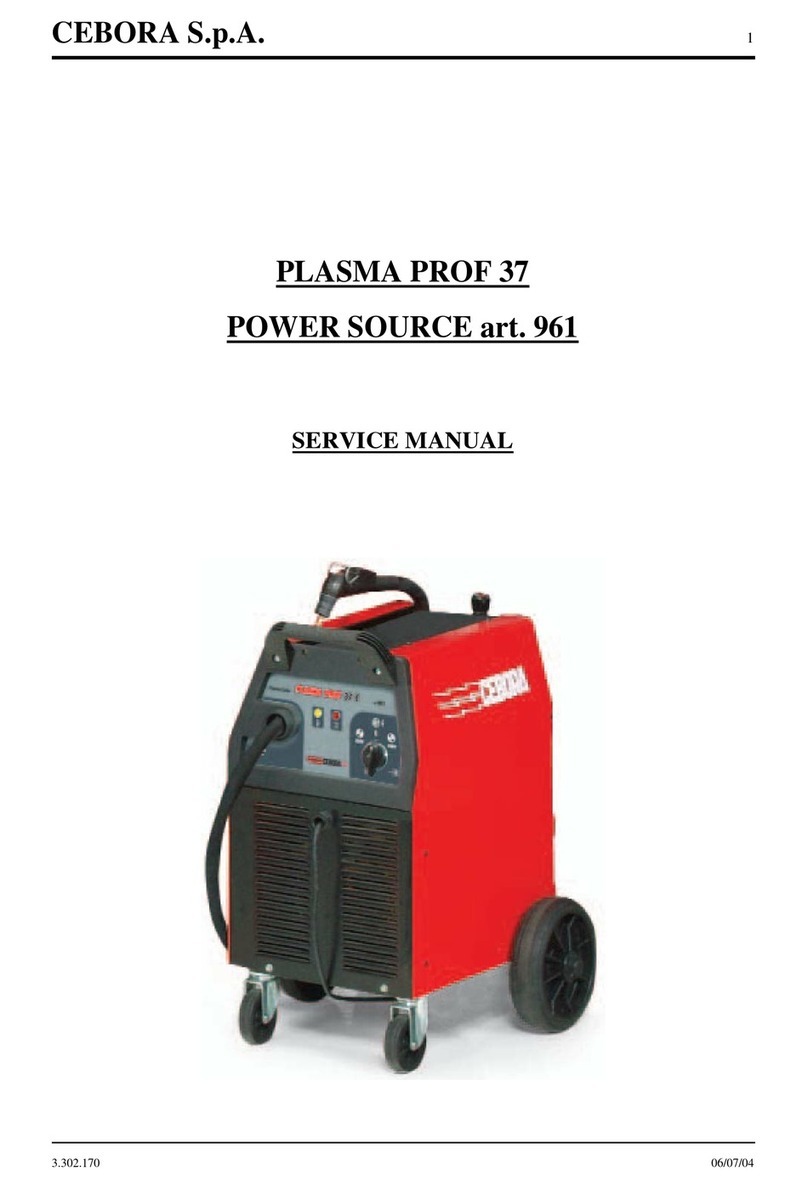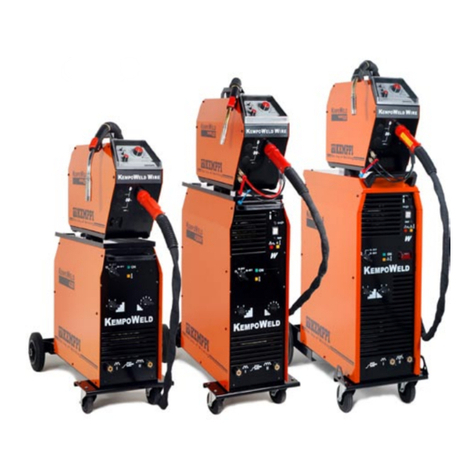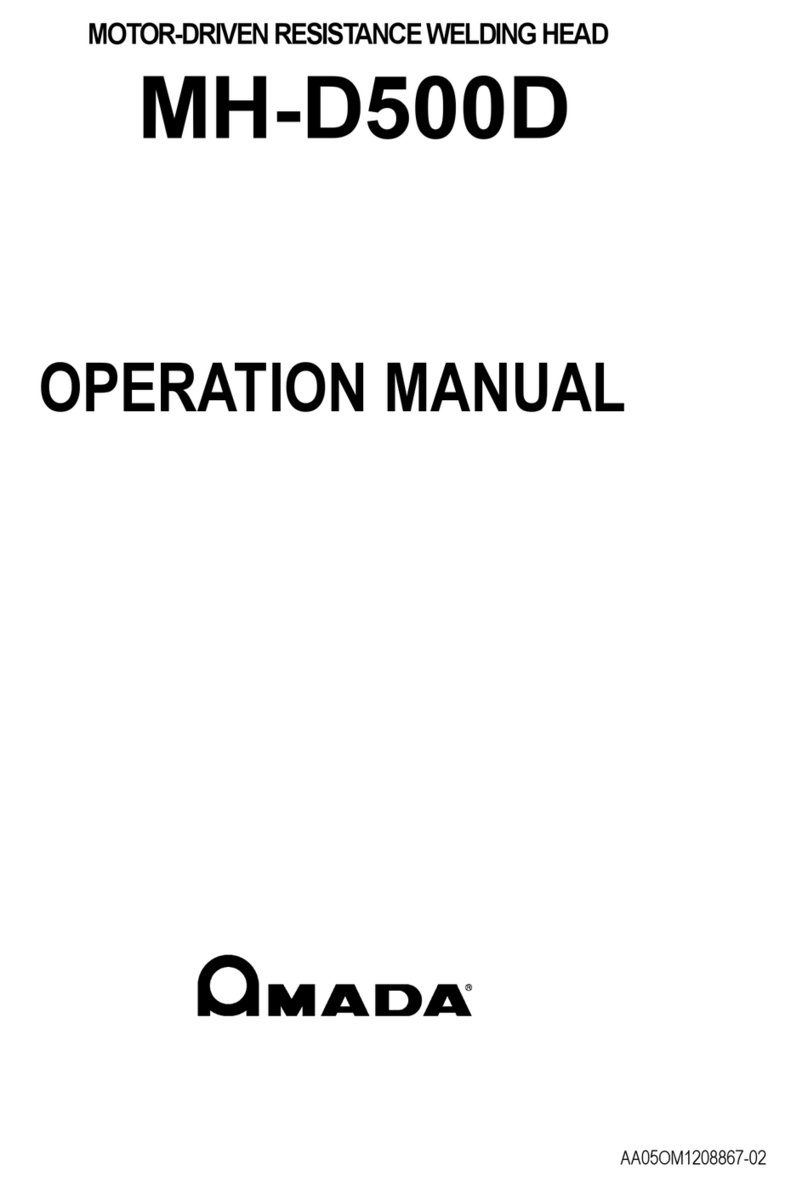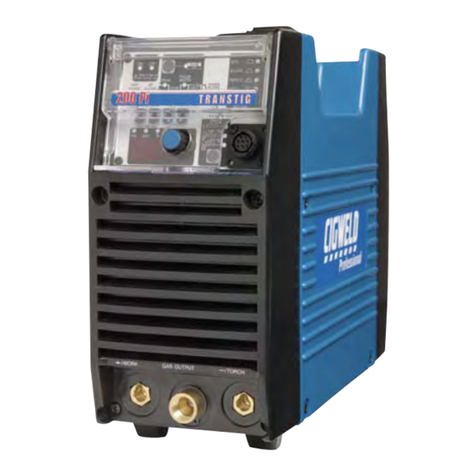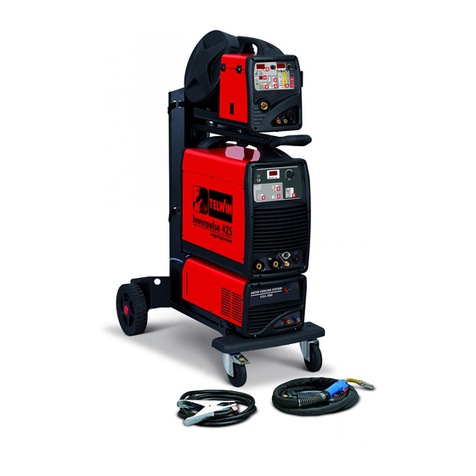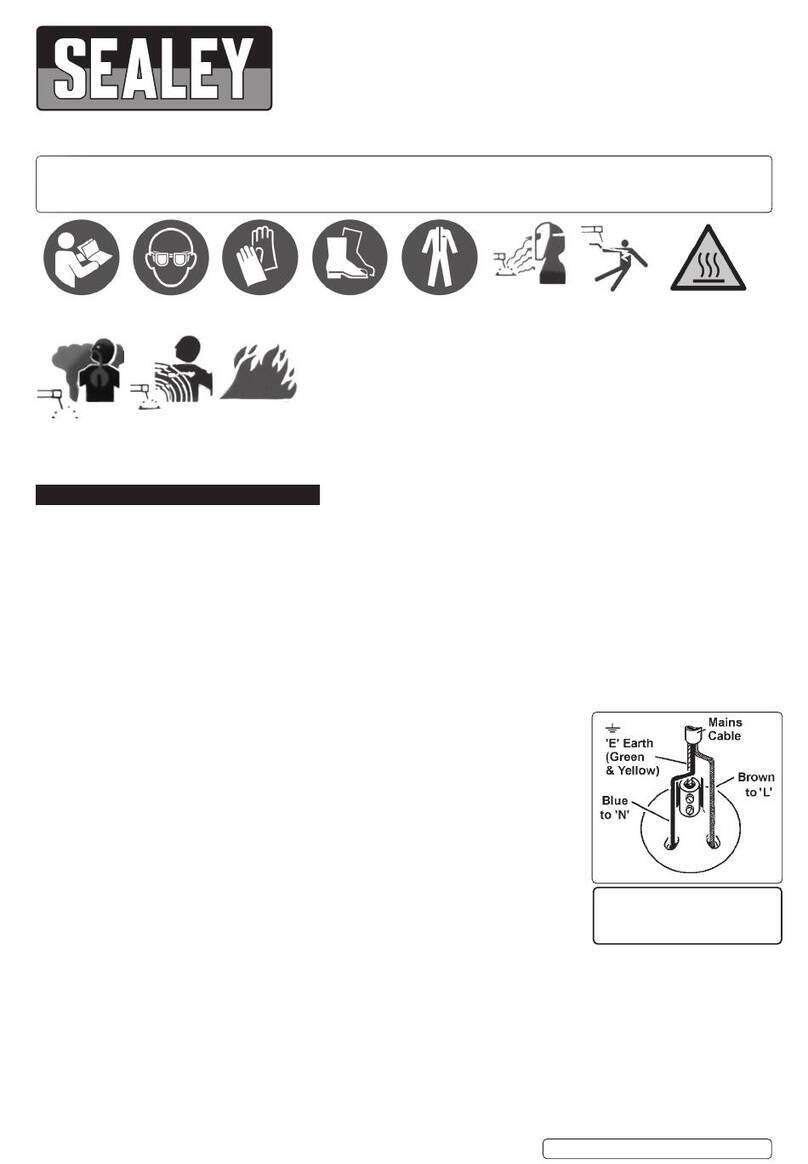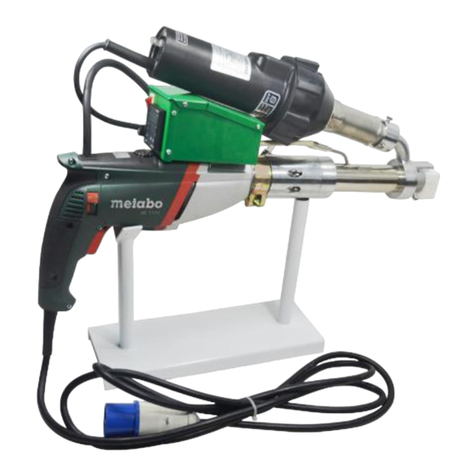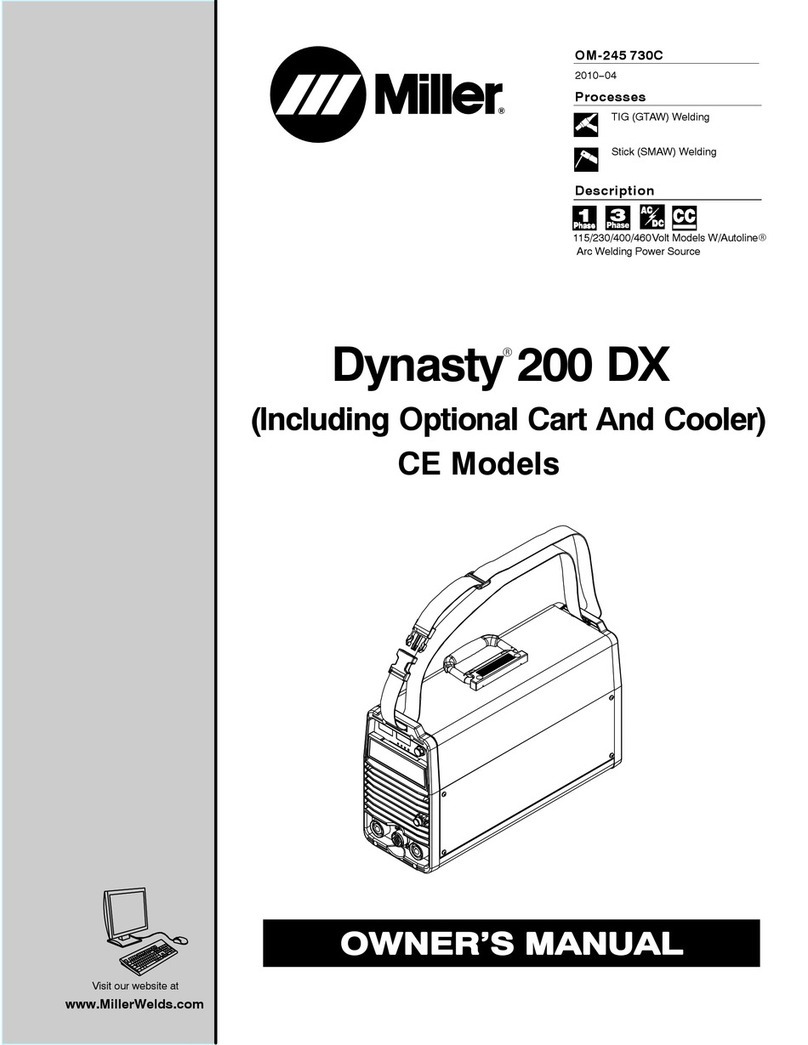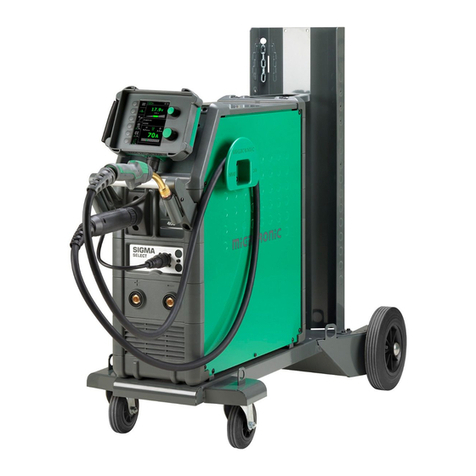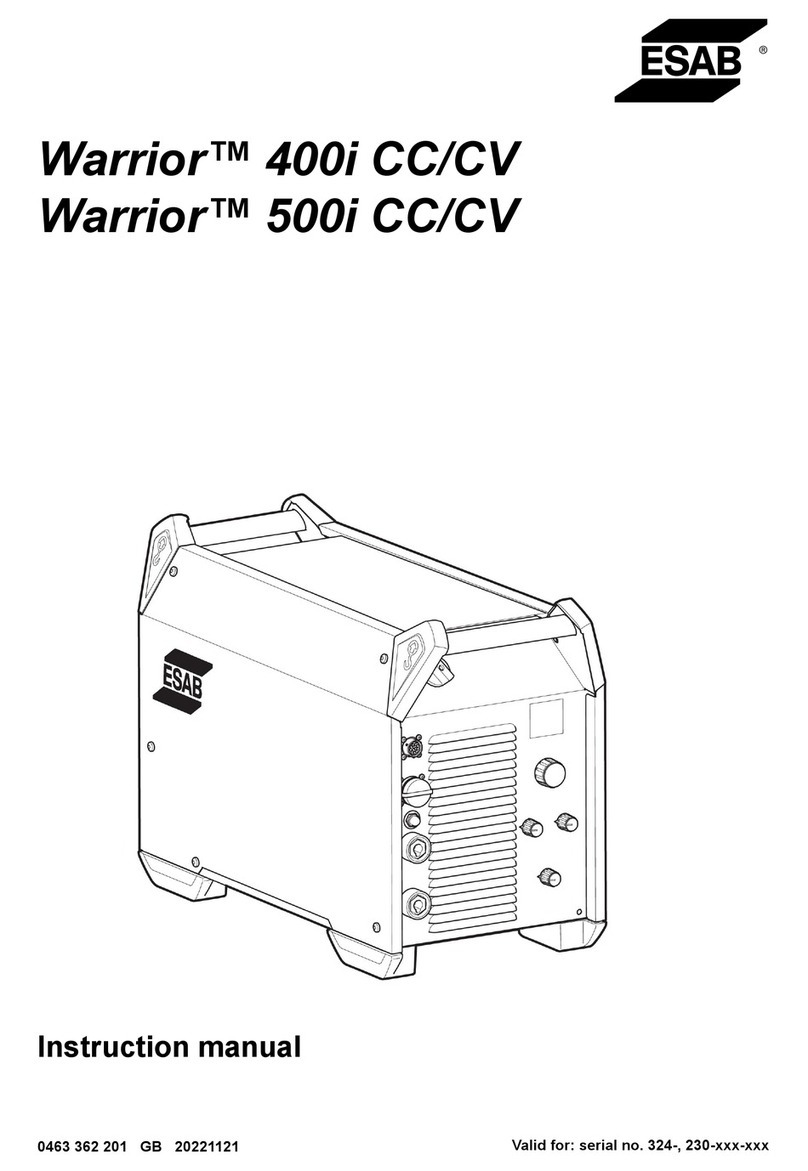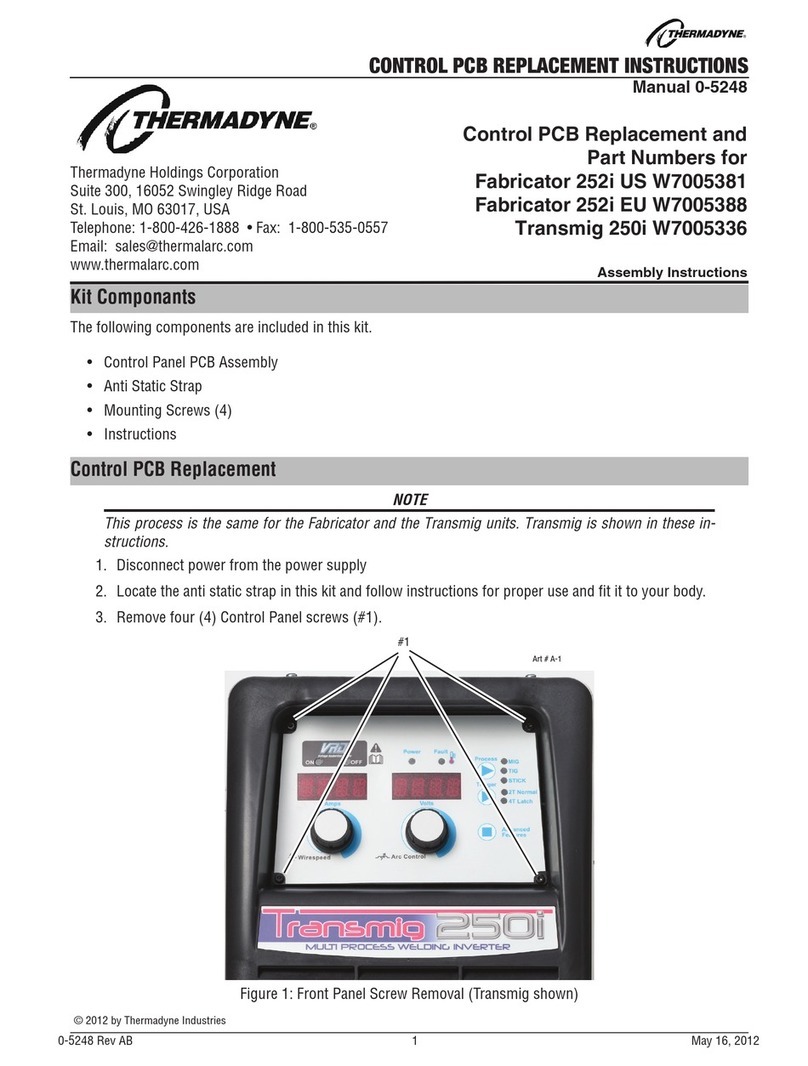Pro-tec FC-120 Instructions for use


- 1 -
Description: This machine is used to weld ferrous or nonferrous metals.
Disclaimer: The information, illustrations and instructions described in this manual
are based on the latest product information available at the time of publication. The
manufacturer and distributors reserve the right to make modifications at any time as
a result of product changes, and such modifications are not obligated to notify any
organization or individual. In addition, welder is a special type of work, and welding
equipment is special equipment. Welding work must be executed by qualified
workers after professional training. Therefore, the manufacturer and distributors are
only responsible for the quality of the product. They shall not be liable for direct or
indirect joint and several liability including loss of profit caused by omissions or
misdescriptions that may exist in this operation manual. This manual will contain as
much as possible the safety operation and preventive measures related to this
equipment, but cannot completely exclude the occurrence of accidents. The
manufacturer and distributors shall not be liable for any direct or indirect joint and
several liability, for any incidental or consequential damages caused by any accident,
that may occur outside of this manual. For more detailed health and safety
information, please contact the relevant professional agencies, welding materials or
welding flux manufacturers if necessary..
No warranty service is available in the following circumstances:
The consumables of the machine are not covered by the warranty, such as
welding wires, welding flux, fuse, quick connector, drive roller, tension roller, etc..
Machine failures caused by incorrect input power voltage or fluctuating power
supply are not covered by the warranty.
Malfunction of the machine and parts damage caused by wrong connection or
incorrect operation.
The warranty will be invalid if the machine is disassembled or refitted without the
permission of the manufacturer, resulting in accidental work or unexpected
damage of the machine.
Accidental damage during transportation, storage, and transshipment.
Problems caused by man-made damage, natural disaster of force majeure and
accidental damage.

- 2 -
CONTENTS
Safety precautions.................................................................................. 3
Warnings...................................................................................................4
Package and transportation........................................................................... 8
Parameters........................................................................................................9
Product description..........................................................................................9
Working principle........................................................................................... 13
Installation and wiring................................................................................... 13
Brief instruction for welding operation........................................................17
Maintenance................................................................................................... 18
Common machine malfunctions and solutions.........................................19

- 3 -
Safety precautions
The equipment is designed for the qualified personnel who have passed professional
training. The operator shall have sufficient professional knowledge of welding, cutting
and circuit, and have obtained the qualification certificate of welder. Only operate the
machine after reading and fully understanding all the safety precautions and warnings
in the manual and of welding operations. Basic safety precautions should always be
followed when using tools, to reduce the risk of personal injury and damage to
equipment. The device is simple and reliable in selecting and performing all of its
functions. The operator must strictly follow the safety precautions below and execute
them as required. Improper use and maintenance will reduce the safety performance
of the machine.
1. The operator must have passed the systematic training and assessment of local
welder's relevant learning institution and obtained the qualified certificate before
operating the equipment.
2. The wire and cable connection of the equipment, as well as the installation, must
be operated by qualified professional and technical personnel.
3. The welding and cutting protective equipment used by the operator must be
provided by the manufacturer or distributor approved by the national safety
supervision department of the local country.
4. Welding and cutting is dangerous work, which may cause harm to you or others,
so sufficient protection should be done during welding and cutting. Please strictly
abide by the relevant safety precautions of the job operation. For more details, please
refer to the relevant safety guidelines for the operators to comply with the
manufacturer's regulations on accident prevention.
5. Please make sure that the welding/cutting machine is reliably grounded when
working. Please contact the professional electrician to solve the problems in time if
there is any doubt that the socket is not grounded or the grounding is not reliable.
6. Before welding/cutting , check whether the insulation layer of all wires and cables
of the machine is damaged or they are wrongly connected timely and fix them in a
timely manner if they are.
7. The faulty machine must be repaired by professional technicians. The machine
must be disconnected from the electricity supply before repair and maintenance.

- 4 -
8. Do not operate the welding/cutting machine in humid environment, otherwise it
may cause electric shock or short circuit accident.
9. It is strictly forbidden to re-modify the equipment or the attached equipment
related to the operation of the equipment without permission, to avoid accidents.
10.The disposal of the scrap equipment must comply with the relevant policies and
regulations of the local government.
Warnings
Welding and cutting is a special type of work, with a certain degree of danger.
Professional training, correct operation and necessary protective measures can
effectively avoid and reduce the damage and loss caused by machine accidents.
Personal and others’ safety protection
When welding and cutting equipment is working, it will generate
noise, strong light and high temperature sparks, which will cause
harm to human hearing, eyes and skin. Correct protective measures
and proper operation training are necessary to prevent injury
accidents.
1
Aprotective helmet with a shading filter must be worn to protect the face and
eyes during welding and cutting operations or when watching welding/cutting
operations.
2
Wear a helmet with the correct filter and cover plate to protect the eyes, face,
neck and ears from arcing sparks and bright light during welding operation or
observation. Warn bystanders not to look at the arc and not to expose their
skin in the area of strong light arc or high temperature spark
3
Wear flame retardant gloves, flame retardant welding/cutting overalls, flame
retardant shoes, and welding/cutting helmets or protective caps to protect
against arcing bright lights, high temperature sparks or hot metal particles. A
flame retardant apron is also available to protect against thermal radiation
and high temperature sparks.
4
Hot sparks or metal can get into rolled-up sleeves, trouser legs or pockets.
Before welding/cutting, sleeves and collars should be buttoned, and clothes
with front pockets should not be worn.

- 5 -
5
Use appropriate flame retardant shields or curtains to protect other persons
from arc radiation and high temperature sparks.
6
Welding slag has high temperature, and can be splashed over a long
distance. During the removal of welding slag, the operator and viewers
should wear additional safety goggles over safety glasses.
7
It is forbidden to touch the welding work piece with bare hands to avoid
accidental scald and burn.
Fire and explosion precaution
During welding and cutting, high temperature flame and arc will be
generated, which will cause fire; high temperature welding slag and
sparks will also cause fire and explosion.
1
Protect yourself and others from flying sparks and hot metal
2
Flammable and explosive items are not allowed to be placed in the
welding/cutting area. Flammable materials that needed to be used in
welding/cutting process must be covered with flame retardant materials.
3
Hot sparks and metal can fly into cracked floors and walls, which need to be
protected against fire hazards.
4
Do not weld and cut on sealed high-pressure gas tanks, which may cause
explosions.
5
Fire extinguishing equipment, such as fire hose, water bucket, sand bucket
or portable fire extinguisher, must be provided in the welding and cutting
area. Furthermore, regularly check the effectiveness of these fire
extinguishing equipment, and carry out the training on the safe use of these
fire extinguishing equipment.
6
After finishing the welding/cutting operation, check whether there is high
temperature spark or metal, which might cause fire and timely dispose. If
necessary, go to the firefighter for help.

- 6 -
Prevention of Electric Shock Injuries
A person contacting with live electrical components or machine can
produce an electric shock, which will cause serious injury to the
human body or death. Do not use welding/cutting machines in
humid environment where movement is limited or there is a risk of
falling.
1
Ensure reliable grounding of the machine to prevent electric shock accident
caused by electric leakage.
2
Make sure that the work piece connected to the ground clamp of the machine
is reliably grounded.
3
Connect the ground clamp with the work piece reliably, or it might cause
electric shock accident.
4
Check the wires and cables frequently, and replace it in time if the insulation
layer is damaged.
5
Keep everything dry when welding/cutting, including clothing, working area,
cables, flashlights, electrode stand and power supply.
6
Make sure that every part of your body will not contact with the live electrical
parts.
7
Never stand directly on metal or the ground when have to work in a narrow or
humid environment. Please stand on dry wood or insulating platform,
wearing shoes with insulated rubber sole.
8
Please wear dry gloves without holes when turn on the machine power.
9
Please turn off the machine before taking off the gloves.
10
It is forbidden to replace the ground cable of the machine with other wires
and cables.
11
There is high voltage inside the machine. Non-professionals are strictly
forbidden to open the casing or start the machine for maintenance.
Protective Measures for Electromagnetic Fields
When an electric current flows through a conductor, it generates an
electromagnetic field, which can be harmful to the human body.
1
Welders with cardiac pacemakers shall consult a doctor if they are suitable
for welding and cutting operations.

- 7 -
2
Human exposed to the electromagnetic field may cause unknown health
effects.
3
Welders should minimize electromagnetic field damage through the following
methods.
3.1
Wrap the electrodes and the working cable with insulating cloth and secure
them with tape if possible.
3.2
Do not wrap wires and cables around arms.
3.3
Do not put cables around your body. Put the cables on one side if possible.
3.4
The clamping position on the work piece, by the working cable, should be as
close as possible to the area to be welded or cut.
3.5
The welding/cutting machine and cable shall not be close to the body during
operation.
Protection Against Fumes and Gas
Welding and cutting produces a lot of fumes and gas, which is
harmful to human health.
1
Keep your head out of the fumes. Do not breathe the fumes.
2
Keep well ventilation in welding/cutting working environment. Do not weld or
cut in a confined space and there must be an air exhaust and dust remove
system.
3
Do not weld in locations near degreasing or spraying operations. The heat
and arc produced in the operation can react with chlorinated hydrocarbon to
form highly toxic and irritating gases, which is harmful to the human body
and might cause birth defects, and in some cases, can lead to cancer.
4
If you experience temporary eye, nose, or throat discomfort during
welding/cutting operation, it may be caused by inadequate ventilation.
Please stop the operation immediately and take measures to improve
ventilation in the working area.
5
For specific ventilation requirements of welding and cutting working area,
please refer to relevant documents of welder profession.

- 8 -
Gas Cylinder Safety
Cylinders connected to welding/cutting equipment may rupture and
leak gas, if not being properly operated. A sudden rupture of a
cylinder valve or relief valve can cause injury or even death to
human body.
1
The cylinder should be away from high temperature and fire source. Do not
use hard objects to scratch on the cylinder body.
2
A suitable gas should be selected and stored in the cylinder during welding
and cutting. The pressure reducing valve should be installed on the cylinder
according to the cylinder manufacturer's operating instructions. Do not use
quick connectors for cylinder gas hose connection and please make sure
that the gas hose and fittings is reliably connected, without any leakage.
3
Keep cylinders fixed upright at all times and the cylinder can be chained or
belted to a suitable trolley, base, wall, post or shelf. Never fix the cylinder to
the work table or machine, to avoid they become part of the circuit.
4
Ensure that the cylinder valve is closed when it is not in use. If there is no
hose connected to the cylinder, put a dust cap on the valve port in time.
Moving Parts Safe Protection
Moving parts, such as fans, rotors and belts, can be
hazardous.
1
Before welding/cutting, keep all doors, panels, covers closed.
2
Only qualified professionals and technicians can remove the machine casing
for maintenance.
3
Make sure that hands, hair, clothing and tools are out of movement range of
the moving parts
Package and transportation
1. During packaging, storage and transportation, please pay attention to the
placement identification, waterproof identification, bearing identification, layer number
identification and other protective identifications on the package.
2. During the transportation and transshipment, it is prohibited to throw the
products at will, and strong impact and vibration are prohibited.

- 9 -
3. Equipment should be stored in a rainproof, moisture-proof and well ventilated
place, and the ambient temperature of storage should be -25℃~55℃.
Parameters
Model
FC-120
FC-120ECO
FC-120
Item
Value
Rated input voltage
AC220V±15%
50/60Hz 1PH
AC110V±15%
50/60Hz 1PH
Rated input power
5.1kVA
9.2kVA
Rated input current
23A
42A
Rated duty cycle
60%
Output current range
(A)
30-120(MIG)
20-120(MMA)
130-120
(MIG)
30-120(MIG)
20-120(MMA)
Open circuit voltage
60V
Efficiency
≥85%
Insulation grade
F
IP grade
IP21
Package dimensions
430*220*320(mm)
N.W.(kg)
7.25
7.0
7.25
Product description
This series flux cored wire welding machine inverts 50Hz/60Hz power supply into
high frequency high voltage power supply (up to 33KHz), through a high power device
IGBT, and then after step-down rectifying and pulse width modulation(PWM)
technology, output high power DC supply for welding. Thanks to the advanced
inverter technology, the weight and volume of the main transformer are greatly
reduced, and the efficiency is increased by 30%, which features stable and reliable
quality, lightweight and energy saving performance, etc..
This series of inverter MIG welding machine is a kind of high performance
semi-automatic welding machine for flux cored wire welding. The self-shielded

- 10 -
flux-cored wire protects the droplet and weld pool by the slag forming constituents
and the gas forming constituents of the flux-cored wire which produce gas and slag
under the high temperature of the arc. The self-shielded flux-cored wire welding
carries the advantages that it doesn't required an external shielding gas, simple
welding torch structure with light weight and easy to operate; it delivers good
performance on wind resistance and gas pore resistance. In the welding process, the
shielding gas is formed by the metallurgical reaction of the welding wire itself. It can
be welded under wind class 4 that is particularly suited for field operation; it provides
deep penetration and uses spray transfer method which produces small spatters; It
has excellent operation performance of all position vertical down welding; it also
provides excellent slag detachability. The deposited metal is able to obtain high
low-temperature toughness under the harsh conditions of low temperature, strong
wind and other situations. This machine can weld low carbon steel, low alloy steel,
stainless steel and other components, using Φ0.8-Φ1.0mm diameter flux-cored wire,
and it is widely used in pipeline construction , ocean engineering, outdoor large steel
structure manufacturing, steel structural high-rise building, resurfacing welding and
other industries.
Other than above features, this series of inverter welding machines have good
dynamic performance, stable arc, excellent welding results, easy to control and other
benefits. The machines are manufactured in accordance with IEC60974-1 <Arc
Welding Equipment -- Part 1: Welding Power Sources>, Safety Requirements for Arc
Welding Equipment.
1. This series of welding machines have following features:
1.1. Light weight, simply design, small in size, high efficiency and energy saving,
convenient to move.
1.2. Simple operation interface with synergy control, easy to use.
1.3. The closed-loop control system ensures a more stable welding voltage in the
case of grid voltage fluctuation and the change of arc length; an excellent arc
self-regulation, and a stable welding process.
1.4. Less spatter and high metal deposition rate; nice welding bead and less
deformation.
1.5. MMA function is designed to weld various electrodes like acid, alkaline,
stainless steel, etc with excellent performance. Meanwhile, it can be used to weld

- 11 -
with different diameter electrodes in ø2.0mm/ø3.2mm;
1.6. With overheat and overvoltage protection functions, it is safe, reliable and
convenient for troubleshooting.
1. Appearance:
FC-120
Panel:
1
'LED display': display real-time current output ; display values during
parameter settings.
2
'Push-button, welding process': Select among Flux0.8、Flux1.0、MMA、Lift
TIG. The machine is working under the process when the corresponding
indicator light is on.
3
'Coupling device, positive pole (+)': connected with earth wire clamp which
clamps the work piece. Under MMA mode, connected with earth wire clamp,
which clamps the work piece in direct current electrode negative way;
connected with electrode holder in direct current electrode positive way.
1
7
8
2
3
9
1
5
6
1
4
1
1
5
6
2
1
4
7

- 12 -
4
'AC110V or AC220V power light.'
5
'Error indicator light': When the machine functions normally, this light is
always off. It will lit when abnormal conditions occur.
6
'Voltage adjustment knob':rotate to regulate the output voltage.
7
'Current adjustment knob':rotate to regulate the output welding current.
8
'Coupling device, negative pole (-)': under MMA mode, connect the
electrode holder to the negative terminal in direct current electrode
negative way, and connect the earth wire clamp which clamps the work
piece to the negative terminal in direct current electrode positive way.
9
'Integrated gas-shielded torch'
FC-120ECO
Panel:
1
'Push-button, wire diameter': select between 0.8 and 1.0. The machine is
working under the process when the corresponding indicator light is on.
2
'Coupling device, positive pole (+)': connected with earth wire clamp which
2
1
3
4
5
6
7
4
5
1
1
3
6

- 13 -
clamps the work piece.
3
'AC220V power light.'
4
'Error indicator light': When the machine functions normally, this light is
always off. It will lit when abnormal conditions occur.
5
'Voltage adjustment knob':rotate to regulate the output voltage.
6
'Current adjustment knob':rotate to regulate the output welding current.
7
'Integrated gas-shielded torch'
Working Principle
1. Working principle diagram
1.1. Covert the alternating-current input into direct-current output by a bridge
rectifier;
1.2. Under the control of PWM, IGBT inverts the above-mentioned direct current
into 33 KHz alternating-current and transmits power through high-frequency
transformer;
1.3. Output the welding current that meets the requirements set after secondary
rectification and reactor filtering;
1.4. Protection circuit works in time and provides signal to PWM circuit (overheat,
overcurrent);
1.5. The closed-loop control method is adopted to make the cutting power source
have good anti-grid fluctuation ability and excellent cutting performance.
Installation and wiring
1. Requirements for installation location
1.1. The cutting machine should not be installed in a location exposed to direct
sunlight and rain. Install and keep it in a low humidity and little dust environment, and
within the ambient air temperature range of - 10 ℃~ 40 ℃.
1.2. The machine shall not be placed on an inclined surface, the ground surface
shall be flat, and the inclination of the welding machine shall not exceed 10 °.

- 14 -
1.3. Ensure no wind at the working station, and suitable precautions should be
taken to prevent wind.
1.4. Keep at least 20cm space in front and back of the cutting machine body, and
at least 10cm space on the left and right sides to ensure good ventilation conditions
around the machine.
2. Requirements of power input
The power supply waveform should be standard sin wave, the rated voltage is
220V/110V±15% with 50Hz or 60Hz frequency.
Model
FC-120
FC-120ECO
FC-120
Parameters
Value
Power supply:
AC220V±15% 50/60Hz 1PH
AC110V±15%
50/60Hz 1PH
Rated input current:
23A
23A
42A
Input cable:
≥2.0mm2
≥2.0mm2
≥4.0mm2
Output cable:
14mm2
14mm2
14mm2
Ground cable:
≥2.0mm2
≥2.0mm2
≥4.0mm2
3. Connection of machine power supply
Pay attention to
prevent electric shock
Wear goggles
Warning: The followings should be aware of when connecting the cutting
machine to a power supply
a) The connection of power cord must be carried out by qualified electricians
and technicians.
b) The connection of power cord must comply with national and local policies
and regulations.
c) Before connecting the power supply, the power supply of the electric control
box must be disconnected.
d) A ground cable must be connected from the power supply to the work, and
the ground cable has a reliable grounding terminal. The yellow green earth

- 15 -
wire of the machine must be reliably connected with the grounding cable.
e) Before connecting the power cords, it is necessary to confirm the
parameters of the power supply on the name plate of the machine which
allowed to be connected, and verify the input power supply is consistent
with the allowable power supply of the machine.
f) The thread pressing screws must be pressed tightly, and cannot be loose
and fake connection.
g) Power supply wiring is as follows
Wiring of single phase AC220V/AC110V 50/60Hzwelding machine
No.
Item
No.
Item
1
Cutting machine
3
Live wire terminal block
2
Power cord
4
Electric control box
2a
Live wire L
5
Earth wire terminal block
2b
Neutral wire N
6
GND
2c
Earth wire
7
Overcurrent protection device
2c
2
2b
2a
3
4
7
6
1
5

- 16 -
4. Installation and adjustment of wire spool
4.1. Installation of wire spool
Attention:
Before putting the wire spool into the hub shaft, find the locating pin on the shaft and
the locating hole on the spool; Then align the hole with the pin and push the wire
spool into the hub shaft.
Installation of wire spool
Installation of 5kg(Ø200mm)wire spool
No.
Item
No.
Item
1
Wire spool hub shaft
3
Fixing nut
2
Wire spool
5. Use of the wire feeder
5.1. Introduction
No.
Item
No.
Item
1
Wire feeder motor
3
Drive roll
2
Pressure regulating handle
4
Tensioner roller
1
2
3
locating hole
locating pin
2
3
3
3
1
3
4
3

- 17 -
5.2. How to select tensioner roller and drive roll
Tensioner
roller
Non-groove
Drive roller
V groove
knurled
V groove roll:
Suitable for some hard wire like solid
carbon steel wire and stainless steel wire
Knurled roll:
Suitable for flux cored wire
Brief instruction for welding operation
1. Welding operation procedure
1.1 Wear necessary and qualified welding protective equipment, such as helmet,
mask, goggles, earplug, protective clothing, gloves, insulating shoes, etc.
1.2 Check and confirm that the electrical grid to be connected to the welding
machine is consistent with the allowable power supply of the machine.
1.3 Check and confirm that the insulation layer of all wires and cables of the
welding machine is not damaged, the welding cable and the grounding cable are
connect to the welding machine correctly.
1.4 Check and confirm that the ventilation around the welding machine is freely
vented; there are no sundries on the welding machine body.
1.5 Check and confirm that the ventilation opening of the welding machine has not
be covered or blocked, or the cooling system might fail to work.
1.6 Connect quick connector of the earth wire cable to the positive pole (+) below
the front panel of the machine, and tighten it clockwise; the other end, which is the
earth wire clamp, to clamp the work piece.
1.7 Connect the power cord to the distribution box with the corresponding input
voltage level according to the welding machine’s, do not connect the wrong voltage,
and ensure that the error of the supply voltage is within the allowable range.
1.8 Press the power switch to turn on the machine, work LED is lit, and cooling fan
works.

- 18 -
1.9 Select welding process first and set current parameters on the panel according
to the requirements. Then point the torch towards the work piece and press the
trigger to start welding.
1.10 Carry out the welding operation according to the normal procedure. During
welding, the parameters can be modified according to the actual situation.
1.11 After welding operation is completed, turn off the power switch of welding
machine and the switch of the distribution box.
Maintenance
In order to ensure operation safety, please regularly maintain and overhaul the
welding machine. Must turn off the power switch of input distribution box before
checking the connection terminal blocks inside/outside the machine.
1. Daily precautions:
1.1. Whether there is any abnormal vibrations, sounds or smells?
1.2. Whether there is any sign of overheating in cable connection?
1.3. Whether the fan works smoothly after turning on the power switch?
1.4. Whether the power switch is faulty?
1.5. Whether the cable is correctly connected and properly insulated.
1.6. Whether there is any cable damage?
2. Check lists that should be carried out every 3 ~ 6 months
2.1. Dust remove
Inspection by professional maintenance personnel every 3 to 6 months. Clean all
parts inside the welding machine with dry compressed air. After cleaning the inside of
the machine, the removed side plate should be reset before using the machine again.
Note that if the removed side plate is not reset, the cooling effect of the fan will be
invalid, which may lead to the burning of transformer and semiconductor power
devices. Meanwhile, pay attention to check whether the fastening screws of input and
output connecting cable are loose, whether the contact is tight, and whether the
machine shell is grounded or not.
2.2. Inspection of wire and cable
Inspect the wire and cable every time before welding operation to ensure that the
insulation layer is not damaged, the wiring is correct, and the joint piece is not loose.

- 19 -
2.3. Replacement of contact tip and wire feeder
The contact tip and wire feeder should be replaced in time; clean the wire liner
frequently.
Common machine malfunctions and solutions
Warning:
Machine maintenance must be carried out by qualified professional and
technical personnel!
The highest voltage inside the machine can be reach to 600V!!!
For your safety, do not open the machine cover at will. During maintenance,
safety protection such as preventing electric shock should be prepared well.
The power supply of the machine must be turned off when installing the wiring
and replacing the welding torch accessories
Do not overhaul the machine immediately after the welder has just be turned off.
Please wait at least 5 minutes after turning off the power switch of the machine
and distribution box, so that the capacitor inside the welding machine can be
fully discharged .
1. Inspection before overhaul
1.1. Check whether the line voltage of single-phase power supply is within the
range of 200V ~ 240V, and whether there is phase loss phenomenon;
1.2. Check if power cable of the welding machine is correctly and reliably
connected;
1.3. Check if earth wire of the welding machine is correctly and reliably connected;
1.4. Check whether the wiring connection is correct and whether the contact is firm
and reliable;
2. Common machine problems and troubleshooting
This manual suits for next models
1
Table of contents
Other Pro-tec Welding System manuals

